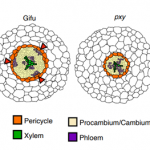Plant Science Research Weekly: April 16, 2021
Review: CRISPR screens in plants: Approaches, guidelines, and future prospects
 We don’t need to remind you of the tremendous positive impact that CRISPR-based technologies have had on the life sciences through enabling any gene to be edited precisely. Here, Gaillochet et al. provide an up-to-date review of a lesser-known application of CRISPR, its use in large-scale screening strategies. The authors start with a refresher in the types of activities that CRISPR systems can have (e.g., deletion, editing, activation), before shifting the focus to the use of CRISPR in screening. To test gene function, libraries of mutations induced by CRISPR have been produced, including a very large one spanning 83% of rice genes, and one addressing the functions of LRR-RLKs in tomato. CRISPR has been used to introduce targeted sequence diversification, for example to slightly modify promoter sequences and so generate alleles with a broad, continuous range of expression levels, and several other sophisticated screening strategies are described. The authors then provide an in-depth look at how to design a CRISPR-knock-out screen, including which editing tool to use, screening format, number of targets, guide RNA library construction etc. The review concludes with a look forward at applications that lie ahead, such as the ability to be able to record gene-editing outcomes at the single cell level. (Summary by Mary Williams @PlantTeaching) Plant Cell 10.1093/plcell/koab099
We don’t need to remind you of the tremendous positive impact that CRISPR-based technologies have had on the life sciences through enabling any gene to be edited precisely. Here, Gaillochet et al. provide an up-to-date review of a lesser-known application of CRISPR, its use in large-scale screening strategies. The authors start with a refresher in the types of activities that CRISPR systems can have (e.g., deletion, editing, activation), before shifting the focus to the use of CRISPR in screening. To test gene function, libraries of mutations induced by CRISPR have been produced, including a very large one spanning 83% of rice genes, and one addressing the functions of LRR-RLKs in tomato. CRISPR has been used to introduce targeted sequence diversification, for example to slightly modify promoter sequences and so generate alleles with a broad, continuous range of expression levels, and several other sophisticated screening strategies are described. The authors then provide an in-depth look at how to design a CRISPR-knock-out screen, including which editing tool to use, screening format, number of targets, guide RNA library construction etc. The review concludes with a look forward at applications that lie ahead, such as the ability to be able to record gene-editing outcomes at the single cell level. (Summary by Mary Williams @PlantTeaching) Plant Cell 10.1093/plcell/koab099
Review: Improving crop yield and resilience through photosynthesis optimisation: panacea or pipe dream?
 Has crop photosynthesis research been successful for increasing yields? This very crucial question is analyzed in a new review by Araus et al. The authors report that there has been no increase that can be described as a “quantum leap,” but they discuss the merits of increasing leaf photosynthesis and the possibility of translating these increases into crop yield. The practical applications of leaf photosynthesis manipulation have been translated so far to only 10 – 15 percent increases in yield. The importance of research on canopy photosynthesis of laminar and non laminar organs is stressed as a possible solution to increase photosynthesis. Source-sink relationships, source capacity, sink strength and partitioning of assimilates are crucial considerations, and the importance of a multiscale, diverse strategy with additive effects is stressed. The authors point out that amassing small incremental changes and integration of these changes to bring about modification at canopy, organ and phenological levels is the key in bringing about increases in crop yields. (Summary by Arun Shanker @arunshanker) J. Exp. Bot. 10.1093/jxb/erab097
Has crop photosynthesis research been successful for increasing yields? This very crucial question is analyzed in a new review by Araus et al. The authors report that there has been no increase that can be described as a “quantum leap,” but they discuss the merits of increasing leaf photosynthesis and the possibility of translating these increases into crop yield. The practical applications of leaf photosynthesis manipulation have been translated so far to only 10 – 15 percent increases in yield. The importance of research on canopy photosynthesis of laminar and non laminar organs is stressed as a possible solution to increase photosynthesis. Source-sink relationships, source capacity, sink strength and partitioning of assimilates are crucial considerations, and the importance of a multiscale, diverse strategy with additive effects is stressed. The authors point out that amassing small incremental changes and integration of these changes to bring about modification at canopy, organ and phenological levels is the key in bringing about increases in crop yields. (Summary by Arun Shanker @arunshanker) J. Exp. Bot. 10.1093/jxb/erab097
A biosensor for the direct visualization of auxin
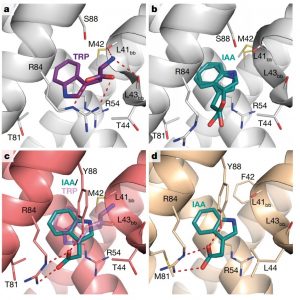 Auxin is an omnipresent, tryptophan-derived phytohormone that plays roles in innumerable physiological processes, so it is imperative to understand its distribution. Currently the best tools to do so employ the use of indirect sensors, such as the synthetic auxin-responsive promoter DR5. While invaluable, these tools suffer from being indirect. In addition, their readouts tend to be irreversible, preventing the study of transient auxin changes. Herud-Sikimić et al. thus developed an auxin biosensor, “AuxSen,” based on the bacterial tryptophan repressor. This genetically encoded sensor undergoes a conformation change upon direct binding to auxin, initiating a FRET signal that can be measured in vivo. Transgenic Arabidopsis lines bearing AuxSen under an inducible expression system corroborated the auxin distributions observed in seedling roots from previous work using DR5 reporter lines. The authors also report a previously-unobserved redistribution of endogenous auxin in roots upon gravistimulation. Given the many key discoveries that have been made in plant biology by studying auxin, it will be exciting to see what new findings this tool will elicit. (Summary by Benjamin Jin) Nature 10.1038/s41586-021-03425-2
Auxin is an omnipresent, tryptophan-derived phytohormone that plays roles in innumerable physiological processes, so it is imperative to understand its distribution. Currently the best tools to do so employ the use of indirect sensors, such as the synthetic auxin-responsive promoter DR5. While invaluable, these tools suffer from being indirect. In addition, their readouts tend to be irreversible, preventing the study of transient auxin changes. Herud-Sikimić et al. thus developed an auxin biosensor, “AuxSen,” based on the bacterial tryptophan repressor. This genetically encoded sensor undergoes a conformation change upon direct binding to auxin, initiating a FRET signal that can be measured in vivo. Transgenic Arabidopsis lines bearing AuxSen under an inducible expression system corroborated the auxin distributions observed in seedling roots from previous work using DR5 reporter lines. The authors also report a previously-unobserved redistribution of endogenous auxin in roots upon gravistimulation. Given the many key discoveries that have been made in plant biology by studying auxin, it will be exciting to see what new findings this tool will elicit. (Summary by Benjamin Jin) Nature 10.1038/s41586-021-03425-2
Magnesium and calcium over-accumulate in the leaves of a schengen3 mutant of Brassica rapa
 Magnesium (Mg) and calcium (Ca) are essential nutrients for plants and also the animals that eat them. Human deficiencies of these elements are not uncommon. Here, Alcock et al. used Inductively Coupled Plasma Mass Spectroscopy to measure the elemental composition of a mutagenized population of Brassica rapa. They identified a line carrying a recessive mutation that led to an elevated accumulation of Mg in most tissues, as well as elevated levels of Ca, but lower than wild-type levels of potassium. They mapped this mutation to a region corresponding to the SHENGEN3 (SGN3) gene, which they named BraA.SGN3.a. This gene was previously characterized in Arabidopsis as contributing to the formation of the impermeable Casparian strip barrier at the root endodermis, with sgn3 mutants having a “leaky” endodermis with increased Mg and decreased K accumulation in leaves (the name Schengen refers to the European Schengen Area, a group of 26 countries that are essentially bounded by a single border). These finding can be used to develop non-GMO foods with enhanced levels of Mg and Ca. (Summary by Mary Williams @PlantTeaching) Plant Physiol. 10.1093/plphys/kiab150
Magnesium (Mg) and calcium (Ca) are essential nutrients for plants and also the animals that eat them. Human deficiencies of these elements are not uncommon. Here, Alcock et al. used Inductively Coupled Plasma Mass Spectroscopy to measure the elemental composition of a mutagenized population of Brassica rapa. They identified a line carrying a recessive mutation that led to an elevated accumulation of Mg in most tissues, as well as elevated levels of Ca, but lower than wild-type levels of potassium. They mapped this mutation to a region corresponding to the SHENGEN3 (SGN3) gene, which they named BraA.SGN3.a. This gene was previously characterized in Arabidopsis as contributing to the formation of the impermeable Casparian strip barrier at the root endodermis, with sgn3 mutants having a “leaky” endodermis with increased Mg and decreased K accumulation in leaves (the name Schengen refers to the European Schengen Area, a group of 26 countries that are essentially bounded by a single border). These finding can be used to develop non-GMO foods with enhanced levels of Mg and Ca. (Summary by Mary Williams @PlantTeaching) Plant Physiol. 10.1093/plphys/kiab150
Who keeps PIF4 high on a hot day? RCB joins HEMERA as a partner in crime
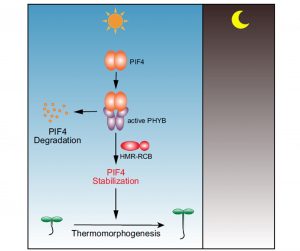 PHYTOCHROME INTERACTING FACTOR4 (PIF4) is a key protein that mediates thermomorphogenic responses in plants. Under warm temperatures, PIF4 levels are high in the daytime even in the presence of active phyB, which is known to induce degradation of PIFs. Thus, in warm temperatures there must be a mechanism that circumvents the phyB-mediated degradation of PIF4. Qiu et al. had previously identified HEMERA, a transcriptional activator that is dual-localized in the nucleus and chloroplast, as necessary for PIF4 stabilization in the daytime. In a new study, they discovered a novel regulatory component that partners with HEMERA. In a genetic screen, they identified a suppressor mutation that can fully rescue the defective thermomorphogenic and photomorphogenic phenotypes of a hem mutant (hem-22). They mapped this point mutation to Regulator of Chloroplast Biogenesis (RCB) that encodes another nucleo-plastid dual-targeted protein, and named it rcb-101. It rescued the impaired PIF4 accumulation in hem-22 and restored the expression of PIF4-target genes. Strikingly, detailed investigation using a null allele (rcb-10) revealed that RCB, similar to HEM, is a promoter of thermomorphogenesis and helps with PIF4 accumulation. RCB and HEM collaborate through physical interaction to stabilize PIF4 and promote temperature signaling. The rescue of hem-22 by rcb-101 is an allele-specific effect, possibly due to altered interaction and/or activities of the mutated proteins. Although the precise mechanism of PIF4 stabilization by the duo remains unclear, the study establishes RCB as a new kid on the block in temperature signaling. (Summary by Yadukrishnan Premachandran @yadukrishprem) Nature Comms. 10.1038/s41467-021-22313-x
PHYTOCHROME INTERACTING FACTOR4 (PIF4) is a key protein that mediates thermomorphogenic responses in plants. Under warm temperatures, PIF4 levels are high in the daytime even in the presence of active phyB, which is known to induce degradation of PIFs. Thus, in warm temperatures there must be a mechanism that circumvents the phyB-mediated degradation of PIF4. Qiu et al. had previously identified HEMERA, a transcriptional activator that is dual-localized in the nucleus and chloroplast, as necessary for PIF4 stabilization in the daytime. In a new study, they discovered a novel regulatory component that partners with HEMERA. In a genetic screen, they identified a suppressor mutation that can fully rescue the defective thermomorphogenic and photomorphogenic phenotypes of a hem mutant (hem-22). They mapped this point mutation to Regulator of Chloroplast Biogenesis (RCB) that encodes another nucleo-plastid dual-targeted protein, and named it rcb-101. It rescued the impaired PIF4 accumulation in hem-22 and restored the expression of PIF4-target genes. Strikingly, detailed investigation using a null allele (rcb-10) revealed that RCB, similar to HEM, is a promoter of thermomorphogenesis and helps with PIF4 accumulation. RCB and HEM collaborate through physical interaction to stabilize PIF4 and promote temperature signaling. The rescue of hem-22 by rcb-101 is an allele-specific effect, possibly due to altered interaction and/or activities of the mutated proteins. Although the precise mechanism of PIF4 stabilization by the duo remains unclear, the study establishes RCB as a new kid on the block in temperature signaling. (Summary by Yadukrishnan Premachandran @yadukrishprem) Nature Comms. 10.1038/s41467-021-22313-x
GABA signalling modulates stomatal opening to enhance plant water use efficiency and drought resilience
 Gamma-aminobutyric acid (GABA) is a non-protein amino acid produced by animals and plants, but is its function conserved across kingdoms? In mammals, GABA acts as chemical messenger in the central nervous system by inhibiting neurotransmission. In plants, GABA accumulates in response to stress but its role in cellular communication is still unresolved. In this study, Xu and coworkers used stomatal guard cells to investigate the function of GABA in plants. Application of exogenous GABA attenuated light-induced stomatal opening in epidermal peels and intact leaves of Arabidopsis. Because stomatal aperture controls water loss, these findings suggested that GABA could play a role in plant response to drought. Arabidopsis gad2 plants with mutations in Glutamate Decarboxylase 2 (GAD2), which encodes the major GABA biosynthetic enzyme, accumulate less GABA in leaves and have increased stomatal aperture. The gad2 mutants also do not accumulate GABA in response to drought treatment and show increased sensitivity to water stress, whereas expression of a constitutively active form of GAD2 in guard cells not only rescued the gad2 phenotype but also improved the recovery of rewatered plants after drought treatment. Additional experiments suggest GABA may function through negative regulation of anion uptake into the guard cell vacuole. The finding that GABA also controls stomatal aperture other dicot and monocot species paves the way for its use to improve water use efficiency and drought resilience in crops. (Summary and image adaptation by Michela Osnato @michela_osnato) Nat. Comms. 10.1038/s41467-021-21694-3
Gamma-aminobutyric acid (GABA) is a non-protein amino acid produced by animals and plants, but is its function conserved across kingdoms? In mammals, GABA acts as chemical messenger in the central nervous system by inhibiting neurotransmission. In plants, GABA accumulates in response to stress but its role in cellular communication is still unresolved. In this study, Xu and coworkers used stomatal guard cells to investigate the function of GABA in plants. Application of exogenous GABA attenuated light-induced stomatal opening in epidermal peels and intact leaves of Arabidopsis. Because stomatal aperture controls water loss, these findings suggested that GABA could play a role in plant response to drought. Arabidopsis gad2 plants with mutations in Glutamate Decarboxylase 2 (GAD2), which encodes the major GABA biosynthetic enzyme, accumulate less GABA in leaves and have increased stomatal aperture. The gad2 mutants also do not accumulate GABA in response to drought treatment and show increased sensitivity to water stress, whereas expression of a constitutively active form of GAD2 in guard cells not only rescued the gad2 phenotype but also improved the recovery of rewatered plants after drought treatment. Additional experiments suggest GABA may function through negative regulation of anion uptake into the guard cell vacuole. The finding that GABA also controls stomatal aperture other dicot and monocot species paves the way for its use to improve water use efficiency and drought resilience in crops. (Summary and image adaptation by Michela Osnato @michela_osnato) Nat. Comms. 10.1038/s41467-021-21694-3
Autophagy promotes photomorphogenesis during seedling development
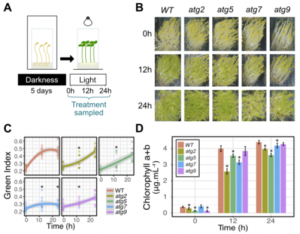 Autophagy is an intracellular evolutionarily conserved catabolic process that degrades cytoplasmic constituents and organelles in lytic vacuoles (micro- and macro-autophagy) or in the cytosol (mega-autophagy). Autophagy can be induced by biotic or abiotic stresses, sugar, carbon and nutrient starvation and also influences various developmental processes. Wijerathna-Yapa et al. investigated the abundance of organelle-specific marker proteins of autophagy mutants in various development transition processes using a targeted proteomics (multiple reaction monitoring, MRM) strategy. They observed atg mutants showed a delayed chloroplast development during dark to light transition. This observation is due to lower photosynthetic and chlorophyll biosynthetic proteins, a reduction in chlorophyll content and size, and also increased abundance of proteins involved in plastid fatty acid biosynthesis. The different abundance of proteins observed in atg mutants are not explained by the differential transcription level. Moreover, the delayed chloroplast development in the atg mutants are neither affected by chloroplast lipid import nor MGDG-DGDG content. The autophagy-related slow-greening observed in the chloroplast development is largely due to a limitation in triglyceride catabolism. This study sheds light on autophagy influences on the rate of etioplast to chloroplast conversion by contributing to lipid turnover and energy production. (Summary by Min May Wong @wongminmay) bioRxiv https:10.1101/2021.03.25.437007
Autophagy is an intracellular evolutionarily conserved catabolic process that degrades cytoplasmic constituents and organelles in lytic vacuoles (micro- and macro-autophagy) or in the cytosol (mega-autophagy). Autophagy can be induced by biotic or abiotic stresses, sugar, carbon and nutrient starvation and also influences various developmental processes. Wijerathna-Yapa et al. investigated the abundance of organelle-specific marker proteins of autophagy mutants in various development transition processes using a targeted proteomics (multiple reaction monitoring, MRM) strategy. They observed atg mutants showed a delayed chloroplast development during dark to light transition. This observation is due to lower photosynthetic and chlorophyll biosynthetic proteins, a reduction in chlorophyll content and size, and also increased abundance of proteins involved in plastid fatty acid biosynthesis. The different abundance of proteins observed in atg mutants are not explained by the differential transcription level. Moreover, the delayed chloroplast development in the atg mutants are neither affected by chloroplast lipid import nor MGDG-DGDG content. The autophagy-related slow-greening observed in the chloroplast development is largely due to a limitation in triglyceride catabolism. This study sheds light on autophagy influences on the rate of etioplast to chloroplast conversion by contributing to lipid turnover and energy production. (Summary by Min May Wong @wongminmay) bioRxiv https:10.1101/2021.03.25.437007
Fossil palm reading using fruits to reveal the deep roots of palm diversity
 One of the biggest challenges when using fossils in plant evolution studies is establishing the phylogenetic relationships between fossils and modern plants. This task is particularly complicated with fossils from flowers or fruits, given the little information available for most groups’ reproductive morphology and anatomy. In this outstanding paper, Matsunaga and Smith build a database of extant palm genera’s fruit morphology by retrieving information from the literature and analyzing fruits using microcomputed X-ray tomography. Tribes within each subfamily had a unique combination of fruit traits, suggesting that increasing our knowledge about palm fruit morphology allows assigning species within taxonomical categories with high confidence. For instance, previously identified fossils were consistently placed within the palm phylogeny in the expected clades using only fruit trait data. As a result, this paper highlights the importance of fruit morphology data and provides a promising starting point for future efforts to incorporate new fossils in evolutionary biology studies. (Summary by Carlos A. Ordóñez-Parra @caordonezparra) Am. J. Bot. 10.1002/ajb2.1616
One of the biggest challenges when using fossils in plant evolution studies is establishing the phylogenetic relationships between fossils and modern plants. This task is particularly complicated with fossils from flowers or fruits, given the little information available for most groups’ reproductive morphology and anatomy. In this outstanding paper, Matsunaga and Smith build a database of extant palm genera’s fruit morphology by retrieving information from the literature and analyzing fruits using microcomputed X-ray tomography. Tribes within each subfamily had a unique combination of fruit traits, suggesting that increasing our knowledge about palm fruit morphology allows assigning species within taxonomical categories with high confidence. For instance, previously identified fossils were consistently placed within the palm phylogeny in the expected clades using only fruit trait data. As a result, this paper highlights the importance of fruit morphology data and provides a promising starting point for future efforts to incorporate new fossils in evolutionary biology studies. (Summary by Carlos A. Ordóñez-Parra @caordonezparra) Am. J. Bot. 10.1002/ajb2.1616
Endosperm turgor pressure both promotes and restricts seed growth and size
 Seed size is a plant trait with agricultural and ecological relevance. However, the mechanisms that determine the final size of seeds are still subject to debate. Here, Creff and colleagues use computational models and mutant experiments to dissect the role of endosperm turgor in Arabidopsis seed size. Typically, turgor drives cell expansion, and previous studies showed that endosperm turgor typically decreases towards the end of seed development as growth slows. However, in haiku2 (iku2) mutants, known for their small seed size, turgor is higher and remains high throughout seed formation. How can increased turgor lead to smaller seeds? Previously, the authors showed that expression of a mechanosensitive gene ELA1 is elevated and induced earlier in iku2 mutants in the outer integument, the cell layer surrounding the endosperm that will give rise to the testa. The authors then used modeling to test the hypothesis that the smaller seed size of the iku2 mutants is caused by precocious stress-dependent stiffening of this region. In support of this model, the authors found an increased expression of pectin methylesterases in the outer integument, which could lead to its precocious stiffening. The authors conclude that the increased endosperm turgor induces precocious testa stiffening and therefore premature growth arrest and smaller seed size. Therefore, this research indicates that endosperm turgor has a dual and antagonistic role in defining seed size and provides fascinating insights into the molecular and biomechanical mechanisms behind it. (Summary by Carlos A. Ordóñez-Parra @caordonezparra) bioRxiv. 10.1101/2021.03.22.436392
Seed size is a plant trait with agricultural and ecological relevance. However, the mechanisms that determine the final size of seeds are still subject to debate. Here, Creff and colleagues use computational models and mutant experiments to dissect the role of endosperm turgor in Arabidopsis seed size. Typically, turgor drives cell expansion, and previous studies showed that endosperm turgor typically decreases towards the end of seed development as growth slows. However, in haiku2 (iku2) mutants, known for their small seed size, turgor is higher and remains high throughout seed formation. How can increased turgor lead to smaller seeds? Previously, the authors showed that expression of a mechanosensitive gene ELA1 is elevated and induced earlier in iku2 mutants in the outer integument, the cell layer surrounding the endosperm that will give rise to the testa. The authors then used modeling to test the hypothesis that the smaller seed size of the iku2 mutants is caused by precocious stress-dependent stiffening of this region. In support of this model, the authors found an increased expression of pectin methylesterases in the outer integument, which could lead to its precocious stiffening. The authors conclude that the increased endosperm turgor induces precocious testa stiffening and therefore premature growth arrest and smaller seed size. Therefore, this research indicates that endosperm turgor has a dual and antagonistic role in defining seed size and provides fascinating insights into the molecular and biomechanical mechanisms behind it. (Summary by Carlos A. Ordóñez-Parra @caordonezparra) bioRxiv. 10.1101/2021.03.22.436392
Natural variation identifies a Pxy gene controlling vascular organization and formation of nodules and lateral roots in Lotus japonicus
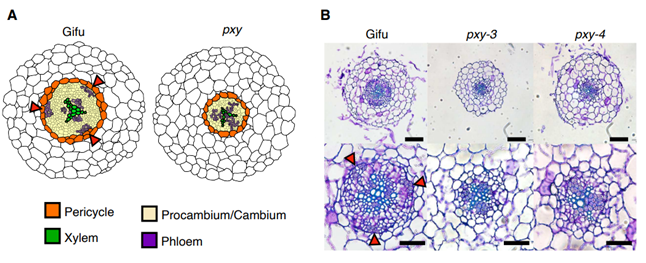 Symbiosis between legumes and nitrogen-fixing bacteria such as Mesorhizobium loti requires an exchange of signals. Plants recognize both specific nod factors (lipochitooligosaccharides) as well as cell-surface exopolysaccharides through distinct pathways. The M. loti exoU mutant fails to properly form exopolysaccharides, and infection fails at the infection thread stage. However, natural variation among accessions of Lotus japonicus has been observed for M. loti exoU mutant response. Hawaharada et al. took advantage of these natural variants and used QTL-seq (Quantitative Trait Locus sequencing) to pinpoint the regulatory gene for the differential response. They identified Pxy (PHLOEM INTERCALATED WITH XYLEM), which has already been characterized as a major player for vascular development in Arabidopsis, and found that the pxy mutants form abnormal nodules. Furthermore, the authors demonstrated that pxy mutants produce fewer xylem cells and lateral roots, demonstrating that the Pxy gene has overlapping roles in lateral root and nodule development, vascular development, and the differential response to exoU. (Summary by Arif Ashraf) New Phytol. 10.1111/nph.17356
Symbiosis between legumes and nitrogen-fixing bacteria such as Mesorhizobium loti requires an exchange of signals. Plants recognize both specific nod factors (lipochitooligosaccharides) as well as cell-surface exopolysaccharides through distinct pathways. The M. loti exoU mutant fails to properly form exopolysaccharides, and infection fails at the infection thread stage. However, natural variation among accessions of Lotus japonicus has been observed for M. loti exoU mutant response. Hawaharada et al. took advantage of these natural variants and used QTL-seq (Quantitative Trait Locus sequencing) to pinpoint the regulatory gene for the differential response. They identified Pxy (PHLOEM INTERCALATED WITH XYLEM), which has already been characterized as a major player for vascular development in Arabidopsis, and found that the pxy mutants form abnormal nodules. Furthermore, the authors demonstrated that pxy mutants produce fewer xylem cells and lateral roots, demonstrating that the Pxy gene has overlapping roles in lateral root and nodule development, vascular development, and the differential response to exoU. (Summary by Arif Ashraf) New Phytol. 10.1111/nph.17356



